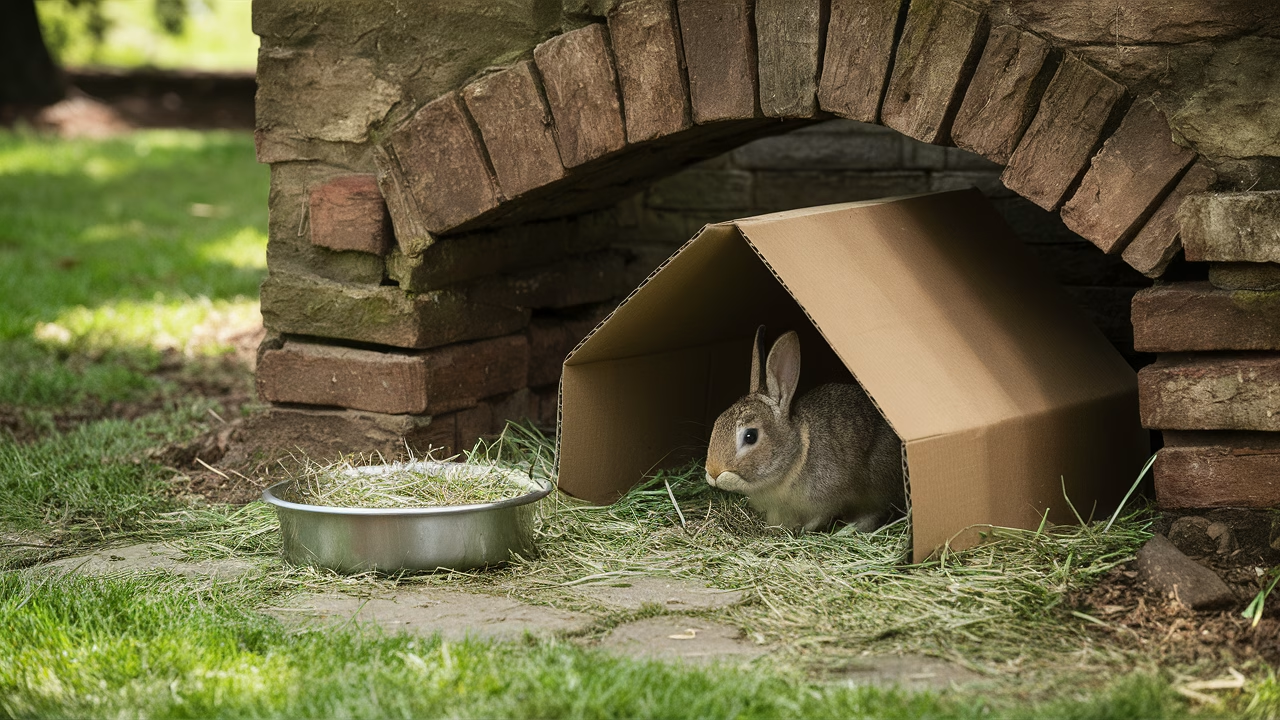What should you do if you find a stray rabbit in Singapore?
If you find a stray rabbit in Singapore, the most important step is to observe from a distance while staying calm. Avoid touching the rabbit directly and immediately call for help from animal welfare groups or authorities. While waiting for professional assistance, you can provide food and water to support the rabbit’s wellbeing, but never release it into the wild as domestic rabbits cannot survive there.
- Stay back: Observing from a distance prevents fright or injury.
- Call for help: Contact AVS, SPCA, HRSS, or a local rabbit rescue.
- Offer care: Provide food and water if possible.
- Keep monitoring: Track its location to aid rescuers.
- Don’t release it: Domestic rabbits can’t survive in the wild.
- Consider adopting: If unclaimed, think about offering a forever home.
Understanding Stray Rabbits
Characteristics and Behavior
Unlike wild animals, domestic rabbits that you find roaming alone in urban areas or parks across Singapore are typically lost or abandoned pets. These rabbits aren’t adapted to fend for themselves—no matter how alert they appear. When you encounter a stray rabbit in Singapore, you’re likely looking at a domestic animal that’s experiencing confusion, fear, and vulnerability in an unfamiliar environment.
Observing from a distance will help you notice key behaviors. Rabbits left outdoors might freeze suddenly or dash unpredictably when alarmed. They’re prey animals by nature and rely heavily on their survival instincts. Trembling, hiding under foliage, or making short runs from shadow to shadow are clear signs they’re feeling exposed and scared.
Remember that domestic rabbits lack the survival instincts necessary for Singapore’s urban landscape. Traffic, loud sounds, and lack of proper shelter all pose serious threats to these vulnerable animals. That’s why taking action quickly when you spot a stray rabbit in Singapore is crucial.
What to Do When You Encounter a Stray Rabbit
Observing from a Safe Distance
The first and most critical step when you find a stray rabbit in Singapore is observing from a distance. Standing 4 to 6 meters away allows you to monitor their wellbeing without escalating their stress levels. This approach protects both you and the rabbit while you assess the situation.
When you observe from a distance, you can safely note important details like the rabbit’s size, color, any visible injuries, and behavior patterns. Is the rabbit limping? Are they grooming themselves? Do they appear alert or lethargic? These observations will be invaluable when you call for help from professional rescue organizations.
Notifying Proper Authorities
Once you’ve safely assessed the situation, it’s time to call for help. In Singapore, you can contact the Animal & Veterinary Service (AVS) at 1800-476-1600, the Society for the Prevention of Cruelty to Animals (SPCA) at 6287-5355, or local rabbit organizations like HRSS or Bunny Wonderland. These groups have trained personnel who understand proper rescue approaches and rabbit care.
When you call for help, provide the exact location, time you spotted the rabbit, detailed behavior observations, and a photo if possible. This information helps volunteers and rescuers understand the rabbit’s condition and develop the best rescue strategy.
Providing Care for a Stray Rabbit
Offering Food and Water
While waiting for professional help, you can provide food and water to support the rabbit’s immediate needs. Offer only rabbit-safe options like fresh hay, leafy greens such as romaine lettuce or coriander, and a shallow bowl of clean water. Never give human food, bread, sugary fruits, or meals meant for other pets.
Place the food at a safe distance from traffic and foot traffic, then continue observing from a distance. Resist the urge to lure the rabbit toward you, as this will likely cause them to panic and potentially injure themselves while fleeing.
Creating a Safe Environment
If the area is secure and the rabbit remains visible, consider creating temporary shelter using cardboard boxes lined with hay or clean towels. Position this refuge in a quiet spot near where you first observed the rabbit, ideally protected from direct sunlight and rain. This provides some protection while professional rescuers mobilize.
Never attempt to confine or capture the rabbit yourself without proper training. Stressed rabbits can panic and injure both themselves and well-meaning rescuers.
Ensuring the Well-Being of Stray Rabbits
Monitoring and Reporting
If you can’t reach authorities immediately, continue observing from a distance and document any changes in the rabbit’s behavior or location. Stray rabbits in Singapore often return to spots where they’ve found food or shelter—it’s a basic survival instinct that can help rescuers locate them.
Keep detailed records of the time, weather conditions, and area safety. These logs provide professional rescuers with valuable information that can improve rescue success rates.
Potential Health Risks
Stray rabbits face serious health risks that make professional intervention essential. When you observe from a distance, watch for signs that indicate urgent medical needs.
- Exposure to parasites like fleas, ticks, and mites
- Overheating or dehydration in Singapore’s tropical climate
- Digestive issues from eating harmful plants
- Stress-induced illness, which can be fatal in rabbits
If you notice bald patches, limping, weepy eyes, or unusual behaviors like twitching or excessive scratching, call for help immediately rather than attempting physical intervention.
Adoption Considerations for Stray Rabbits
Why Rehoming is Better Than Release
You might wonder whether releasing the rabbit in a park would be kinder than involving authorities. The answer is absolutely not. Domestic rabbits are not wild animals and lack the predator-sensing instincts and foraging skills necessary for survival. Releasing them isn’t freedom—it’s condemning them to suffering and death.
If no owner comes forward and the rabbit receives proper veterinary care, you might consider adopting the rabbit and providing them with a loving forever home.
What It Takes To Adopt
Before you consider adopting a stray rabbit you’ve helped rescue, honestly assess your readiness for rabbit ownership. These animals require specialized care, proper diet, regular veterinary check-ups, and a rabbit-proofed living space.
- Do you have time for daily care, exercise, and social interaction?
- Can you afford ongoing veterinary costs and specialized rabbit food?
- Is your home rabbit-safe with no exposed electrical wires or toxic plants?
- Are you prepared for a 7- to 12-year commitment?
If you can answer yes to these questions, you might be the perfect match for a rescued rabbit in need.
Frequently Asked Questions
- Can I keep the rabbit I found?
Only after efforts to find the owner and a health check by professionals. Many rescues also provide adoption assistance. - Is it safe to touch a stray rabbit?
No, avoid direct contact. Rabbits can get stressed easily and may scratch or bite out of fear. - What if the rabbit keeps moving locations?
Track the general area, then inform the rescue teams so they can map movement patterns for capture strategy. - Are domestic and wild rabbits the same?
No. Domestic rabbits don’t have wild survival skills and need human care to survive. - Should I feed the rabbit daily if help doesn’t come?
Yes, but ensure rabbit-safe foods only. Don’t overfeed and keep a watch on condition. - Can rabbits carry diseases?
It’s rare but possible. Use caution and always involve trained rescuers for safe handling. - What’s the best place for rescued rabbits?
Animal shelters or rabbit-specific foster networks are best equipped to care for them long-term.
Comparison Chart: Domestic vs Wild Rabbits
| Feature | Domestic Rabbit | Wild Rabbit |
|---|---|---|
| Appearance | Various colors, floppy ears | Brown-grey, alert upright ears |
| Survival Instinct | Limited, learned indoors | Strong, instinctive |
| Habitat Behavior | Seeks shelter or sits still | Digs burrows, hides fast |
| Common Trust Level | More curious, may approach | Runs at first sight |
Male Red Velvet Mite Mating Habits: Why Rejection Can Be Fatal





